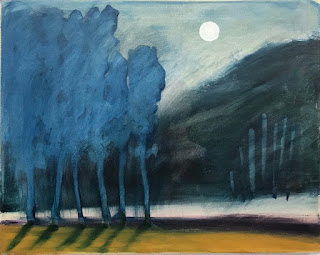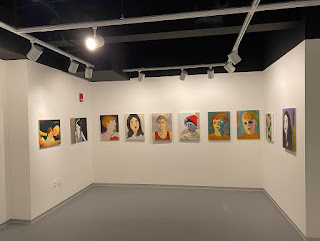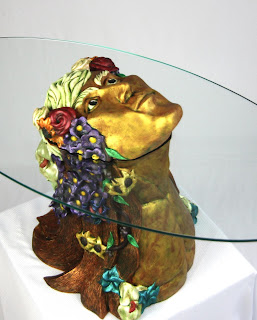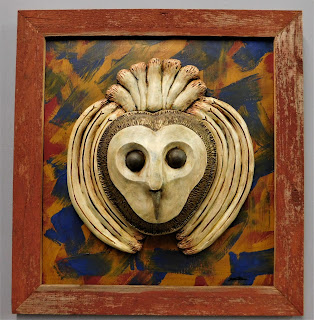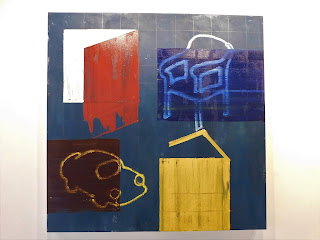Reading Beneath,
Behind, and Between
 |
| Ursa Minor, Facing North / Jack McWhorter |
 |
| Lunch with Picasso / Patricia Zinsmeister Parker |
 |
| Partially Buried 3 / Earl Iselin |
By Tom Wachunas
EXHIBIT: JACK
MCWHORTER: VISIBLE UNIVERSE / PATRICIA ZINSMEISTER PARKER: LUNCH WITH PICASSO /
EARL ISELIN: STACKED
November 4 – 27, 2021
/ The Painting Center, 547 West 27th Street, Suite 500, New York, NY
10001, (212) 343-1060
https://www.thepaintingcenter.org/
I was especially honored to write the
catalogue essay for this exhibit.
Here’s a link for seeing artists bios and their exhibited
works:
https://static1.squarespace.com/static/58e51549cd0f681f932c3e9c/t/617cad918fac1d3a0d07cf2b/1635560852805/McWhorter_Parker_Iselin_Catalogue+2021.pdf
“If good art illustrates anything at all, it’s likely to
be a story you didn’t even know needed telling.” - David Salle
In the
introduction to his 2016 book, How to See, painter and critic David
Salle wrote, “Art is more than a sum of cultural signs: It is a language both
direct and associative, and has a grammar and syntax like any other human
communication.”
This analogy, while
complex and expandable, is useful in “reading” contemporary painting. Think,
then, of the three painters in this exhibit – Jack McWhorter, Patricia
Zinsmeister Parker, and Earl Iselin - as writing in dialects. Each of their
respective dialects is in its way a discreet synchronicity, or a dialogue,
transpiring in unique terrains wherein the painter straddles the fluctuating
boundaries between representation and abstraction.
In the past, Jack
McWcWhorter has characterized his process and product as “personal
archaeology.” For this group of recent paintings on paper, that description
remains potently apropos. Equally potent is the wide arc of his subject matter,
born from his question, “How can one give form to one’s connection with the cosmos
whether it be lost or hidden?” He adds this consideration: “Contemporary
cosmology challenges us to look at nature in new ways and to see the inorganic
world from broad areas; art, astronomy, chemistry, earth sciences and physics.”
At the core of his aesthetic
is a persistent navigation of tensions and harmonies within symbiotic
dualities. His compositions, which he calls “live surfaces,” are clusters or
matrixes of lines, shapes, and patterns that juxtapose accumulations and
singularities, gatherings and dispersals. Like an explorer’s field notes on
remembered sights and sites, places and spaces, his pictures often entwine a
then with a now, as if remembering their own beginnings even as they are
transformed by his imagination into new visual moments.
Live surfaces to
be sure, they’re drawn with a vigorous, gestural immediacy, combining marks
made in broad and loose ways with more concentrated movements of the hand that
we might associate with calligraphy.
Additionally,
McWhorter’s exuberant palette imbues his imagery with a numinous energy,
bringing to their spatial dimensionality a sensation of rhythmic pulsing.
Rising from evanesced fields of personal history and the memories held there,
his transfixing configurations have a heartbeat.
Similarly, visceral
gesture, remarkable chromatic dynamics, and personal history are prominent in
Patricia Zinsmeister Parker’s works. Recently she wrote “I have always believed
that abstract art and representational art are one and the same. It’s just a matter
of scale and particularity.” Her pictures are invigorating records of
spontaneous actions – an immersion in the primacy of painterly impulse and
intuition.
In a spirit of
equanimity, Parker presents her canvases here in pairs, suggesting a continuum,
or conversation, between a non-objective work and one of a relatively more
representational nature. For example, Girl in White Tutu sits beside My Leaky
Fawcet, while Wallflower attends Lunch With Picasso. Two pictures reading as a
single entity, these pairings are unified by one or more formal commonalities,
such as a recurring color, shape, or pattern motif.
There was a period
in Parker’s career when she deliberately painted with her “untrained” left
hand. Consequently, the representational elements in her works regularly
possessed a distinctive awkwardness. She has recently commented that her
leftist approach, if you will, is a thing of the past. Her current paintings
signal a re-emergence of her trained right hand - what she calls her “… return
to figurative work and draughtsmanship skills - those skills being undermined
and buried for decades by the use of my left hand.”
Parker’s drawing
acuity is especially evident in her renderings of female forms. They seem to
emerge from under surrounding scruffy veils or rough layers of paint in a
fluid, even graceful manner, deftly capturing the subtlest of bodily attitudes.
Insightful and
inciteful, Parker makes art that wags a sassy finger in your face and rattles
your sense of “finished” aesthetic decorum. As the sardonic titles of her
paintings suggest, such as Caught in the Act of Painting, she’s a painter
seriously engaged in mindful play, and generous enough to provide us refreshing
cause to chuckle.
Meanwhile, for Earl
Iselin, the act of painting is in many ways an ongoing inquiry into the very
motives and meanings of creativity. Metaphor is certainly an active force in
his iconography. “In five of the paintings I have offered,” he writes, “I’ve
used isometric perspective, which has the penchant to lift, in essence to ‘sky’
the painting, as if to give flight to imagination.”
Those five
paintings share a title, Partially Buried, named after Robert Smithson’s 1970
land art installation, Partially Buried Woodshed. Made on the grounds of Ohio’s
Kent State University when Iselin was living there, it was a site he visited,
occasionally sitting inside, and which he remembers as greatly obscuring his
view of the blue sky, itself a symbol of pure, limitless possibility.
That sensation has
prompted some intriguing philosophizing about history and existence itself.
What he calls ‘skying the painting’ is his way “…of defying the past and
escaping its definition.” Thus his paintings present the shed not as something
dead, collapsed by gravity and entropy, but as a bright-colored geometric
structure, maybe a house, free-floating in an open field dotted with
suggestions of dirt piles or bodies of water.
Meanwhile, his
series of paintings under the collective title of Stack, is a further probing
of history. These smaller individual pieces, some executed in lavishly-hued
impasto, are attached to each other to make large modular grids, evoking a
variety of modernist painting genres such as Color Field, Minimalism,
Expressionism. The Stacks are intended by Iselin to symbolize and encourage
imagination – his, and ours – and to create an energy for really seeing our
present.
And again, Iselin’s
words describe that energy best: “It is…a creative force… to move me beyond the
limitations of my own gravity, beyond myself, that gives purpose to the
painting, a purpose that has everything to do with you. Your sky is as blue as
mine.”
Jack McWhorter.
Patricia Zinsmeister Parker. Earl Iselin. To you, the viewer…enjoy the flight.



